Engaging Activities for Two-Year-Olds: A Parent's Guide
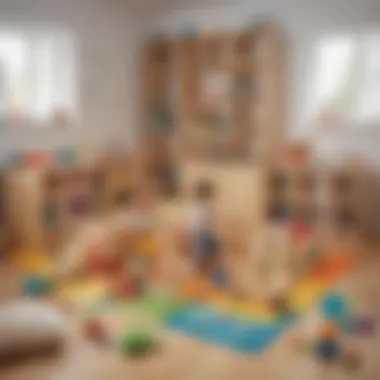

Intro
In the realm of early childhood, two-year-olds exhibit astonishing curiosity and boundless energy. Engaging them through a structured series of activities is essential to their cognitive and social development. Parents and educators can play a pivotal role in molding the experiences of these young learners.
This guide will delve into engaging activities tailored specifically for toddlers, emphasizing their significant benefits. From creative crafts to educational quizzes, each section will examine activities that can systematically enhance learning while providing joyful play. This comprehensive overview supports parents and caregivers as they embark on this journey of exploration, laying a strong foundation for future learning.
Creative Activities
Creative activities stimulate a toddler's imagination and foster fine motor skills. Engaging in crafting not only serves as a fun pastime but also helps children to express themselves artistically. Below are some ideas that can be easily implemented at home or in an educational setting.
Craft Ideas
Engaging your toddler in crafts can be invigorating. Here are a few simple craft ideas:
- Finger Painting: Provides a sensory experience.
- Paper Collages: Use magazines to cut shapes.
- Nature Art: Collect leaves and twigs to create art.
These activities integrate various materials to shape creativity while offering toddlers an opportunity to engage with textures and colors.
Step-by-Step Guides
Finger Painting is very simple to perform. Here’s a step-by-step guide:
- Prepare a washable surface.
- Set up non-toxic paint in multiple colors.
- Allow your child to use fingers, toes, or brushes.
- Encourage them to paint freely without instructions, fostering independent thinking.
The actual experience holds more value than the final artwork itself.
Educational Value
Engaging in crafts like finger painting assists in developing motor skills, enhancing hand-eye coordination. Also, these activities encourage problem-solving skills as children experiment with different ways to create and mix colors. More importantly, craft activities enable creativity, allowing children to think outside the box.
Fun Quizzes
Quizzes serve as engaging learning tools. They can help gauge comprehension while reinforcing knowledge through interaction. The following delve into the specifics of quiz activities suitable for two-year-olds.
Quiz Topics
Some common quiz topics that can capture a toddler's interest include:
- Animals
- Shapes and Colors
- Numbers and Counting
These topics are approachable and relevant. They build foundational knowledge applicable to daily life.
Question Types
Questioons can vary in nature, such as:
- Yes/No questions.
- Multiple-choice formats.
- Picture-based queries to help recognition.
Using visuals can also significantly enhance their engagement levels.
Knowledge Reinforcement
Quizzes, especially interactive ones through apps like ElemFun, dialogue-enables learning. Reinforcing content with varying question types aids in deeper understanding. This approach invites children to recall information accurately and maintains their interest over time.
Fact-Based Articles
Educative articles can serve as excellent resources for both parents and toddlers.
Topics
Topics covered in child-friendly articles might include:
- Dinosaurs
- The Solar System
- Everyday Science Concepts
These topics broaden their knowledge base while keeping information exciting.
Engaging Content
Articles designed for toddlers usually incorporate activity suggestions within the text. This nurturing framework helps to make learning not just about reading but active participation. Furthermore, these resources explain complex ideas simply, making it more accessible for young minds.
Understanding the Developmental Needs of Two-Year-Olds
Understanding the developmental needs of two-year-olds is crucial for both parents and educators. This age marks a significant shift in cognitive, physical, and emotional capabilities. Provisions made for their development help enhance skills useful in the future. When considering engaging activities, recognizing these needs will guide suitable choices that promote valuable growth. Additionally, adapting activities to meet these needs can ensure children derive maximum enjoyment while learning. This section will explore three critical areas: cognitive, physical, and social-emotional development.
Cognitive Development in Early Childhood
Cognitive development in early childhood refers to the ways in which toddlers think, learn, and understand their world. Two-year-olds begin to develop memory skills, recognize familiar faces and objects, and show curiosity about their environment. Engaging activities that promote cognitive skills can include sorting games, simple puzzles, and identification games.
At this stage, toddlers will often ask questions and love to explore different textures. Activities focusing on exploration, such as scavenger hunts that assist in identifying colors and shapes, stimulate cognitive growth. The reinforcement of knowledge through hands-on experiences builds a foundation for more complex learning later.
Key aspects of cognitive development include:
- Language development: Vocabulary expands through repeated listening and interaction.
- Problem-solving skills: Simple challenges engage toddlers and enhance their analytical thinking.
Physical Development Milestones
Physical development allows two-year-olds to master new motor skills, which shows their growing independence. By this age, children typically walk confidently, climb with ease, and begin to show better control during various movements. Attention to motor skills like balance and coordination is essential.
Encouraging activities such as ball play or climbing scaffolds can enhance these capabilities. These activities promote muscle strength and coordination, vital for later complex motor tasks.
Major milestones can include:
- Running and jumping.
- Kicking and throwing a ball.
- Participating in simple obstacle courses.
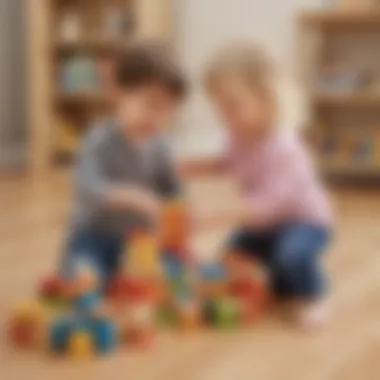
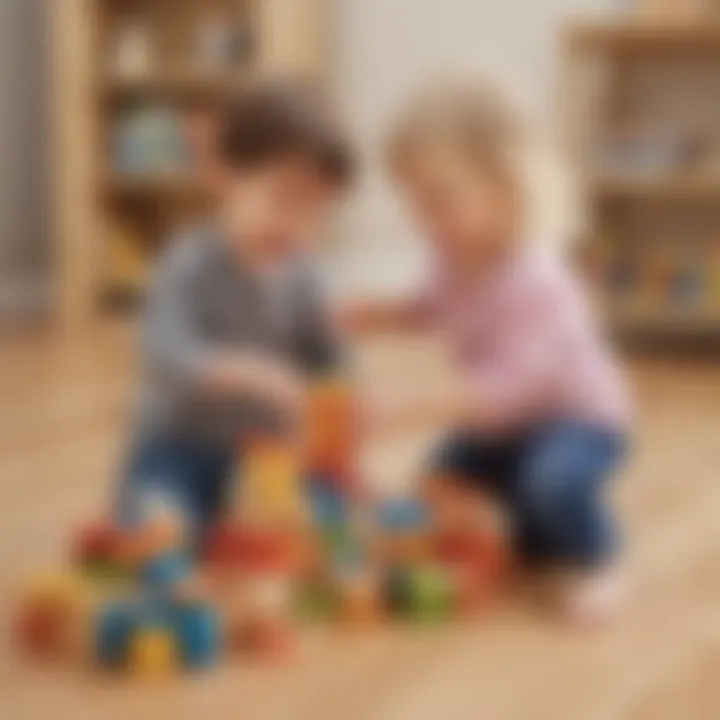
Social and Emotional Growth
Social and emotional growth is equally vital for two-year-olds. This stage includes learning how to share, take turns, and express emotions. Interacting with peers is central to developing social skills. Parents and educators should facilitate group activities that help toddlers practice these important abilities.
Guided play scenarios can blend emotional learning with social integration. Sharing feelings and recognizing emotional responses, even during play, lays a foundation for healthy interpersonal relationships. Concepts of empathy often begin forming during this young age.
Important elements here involve:
- Recognizing personal emotions: Learning to name feelings.
- Understanding others' feelings: Beginning to empathize with peers and caregivers.
In summary, acknowledging the developmental needs of two-year-olds allows for effective planning of activities that nurture their growth. Both cognitive and physical advancements are outcomes of engagement, promoting confidence and a sense of security as children navigate their expanding environments.
Creative Activities That Ignite Imagination
Creative activities serve as a vital cornerstone for developing cognitive, emotional, and physical skills in two-year-olds. These endeavors enable toddlers to express themselves while stimulating their imagination. When engaging in creative activities, children begin to explore their thoughts and ideas more freely. This exploration is essential for their overall development and enhances their ability to problem solve and communicate.
Engaging in creative pursuits can also establish a strong foundation for future learning. It is noticeable how a simple activity like painting or drawing can spur curiosity and invention. Children learn to follow instructions but also feel free to make their own choices, encouraging a sense of independence.
Arts and Crafts Exploration
Basic Drawing Techniques
Basic drawing techniques help two-year-olds develop motor skills and control. Such activities often require the child to hold a crayon or pencil properly, which is necessary for later writing skills. This aspect of drawing also encourages concentration. Many studies show that focused drawing can lead to enhanced attention spans in young children.
A key characteristic of basic drawing is that it is highly adaptable. Learning shapes, lines, or simple forms can be achieved easily through fun variations. An advantage of this technique is the low cost involved, as simple paper and crayons can facilitate numerous activities.
”Drawing is not just a skill, but a language of self-expression.”
Using Safe Materials
Using safe materials is crucial for creative activities with toddlers. Two-year-olds tend to explore objects with their mouth, which necessitates cautious selection of supplies. Safe materials include non-toxic paints, washable markers, and paper. By ensuring the use of non-harmful supplies, caregivers avoid significant risks that lead to accidents.
One alluring characteristic of this practice is that it fosters a worry-free environment. Parents and educators can be assured that children engage in play while staying safe. The unique feature of this approach is its ability to lead to unlimited creativity without health concerns, thus enhancing the significance of creative play for toddlers.
Thematic Crafts
Thematic crafts resonate particularly well with themes children may encounter in life. Seasonal activities around holidays, like adding leaves for fall or cotton for winter, provide a relatable context for toddlers. This form of crafting encourages them to connect their artwork to experiences, enhancing their understanding of the world.
A notable benefit of thematic crafts is the depth it offers to the creative process. Children are immersed in the idea they are crafting, differentiating this approach from random artistic expression. However, the necessary preparations can sometimes deter spontaneous play, producing an organized but slightly rigid environment.
Pretend Play Scenarios
Role-playing Activities
Role-playing activities engage children’s ability to imagine themselves in various roles. This backward-thinking creates opportunities for them to explore scenarios, enhancing emotional intelligence. Through role-play, instinctive social skills are cultivated. These activities present a chance for them to develop empathy by viewing situations from another person's perspective.
A key advantage of role-playing is its structure. By giving children defined roles or scenarios, they feel more prepared to engage socially. However, it might require guidance from an adult to keep the play aligned without ruining the spontaneity.
Using Props Effectively
Using props effectively in play deepens the imaginative experience for toddlers. Props serve as tangible connections to the roles they are playing, making the experience more vivid. Simple props like hats, toy weapons or household items expand the context of play-based learning.
An important characteristic of props is their versatility. Different props can initiate diverse pretend play scenarios. While overly complex setups can discourage improvisation, basic props can confidently drive a child's creativity.
Imaginative Storytelling
Imaginative storytelling not only engages a child’s creativity, it also enriches their vocabulary and comprehension of language. This activity relates closely to a toddler's experiences, allowing them to introduce unique storylines during play. They experiment with narratives which, in turn, leads to improved language skills.
An advantage of storytelling activities is that they can be adjusted to suit any situation, whether alone or part of a group. However, parents should encourage their toddlers to express ideas during underlying plots to prevent them from becoming passive participants, which could undermine the purpose of creative expression.
Educational Activities to Support Learning
Educational activities play a crucial role in developing essential skills for two-year-olds. Children at this age are like sponges, soaking up knowledge and experiencing new challenges. These activities help in forming a strong base in various areas such as cognitive, social, and physical development.
Implementing educational activities has multiple benefits. It enhances their understanding of the world. Educational activities also encourage interaction and build communication skills. That's why it is vital for parents and caregivers to give them a variety of enriching experiences. Consistency in providing these activities may also foster curiosity and a love for learning early on.
Shape and Color Recognition Games
Sorting Tasks
Sorting tasks help toddlers distinguish between different shapes and colors. This activity boosts cognitive skills as children learn to classify objects based on their properties. The key characteristic of sorting tasks is simplicity. They require minimal materials, like colored blocks or assorted shapes. Because this makes them a good choice for parents and educators. It can be easily setup any where.
Unique to sorting tasks is the concept of categorization. Children learn not just to identify shapes or colors but analyse them too. This skill gives them a foundation for later problem-solving abilities. One challenge is keeping toddlers focused for long spans. Simple and brief optimal tasks could work best.
Interactive Board Games
Interactive board games offer an excellent way to engage route learning with play. Games designed for young children often focus on basic concepts. Recognizing colors shapes and also numbers tend to emerge naturally. The interactive nature maintains the child’s attention, making learning enjoyable.
What makes board games stand out is the social aspect. Number of players means sharing. This can promote teamwork and communication in engaging ways. Still, choosing age-appropriate games is essential. Some might be too complex, leading to frustration instead of learning.
Simple Numeracy Activities
Counting Objects
Counting objects is fundamental to understanding preschool math. The specific aspect emcompasses using real items. Such as fruits, toys or blocks assist n learning number recognition in meaningful contexts. One main advantage is active invisitment. Children physically moving objects engages them.
What sets counting activities apart is usability. These activities can easily merged into anywhere - kitchen, backyard or playroom. This accessibility promotes learning in casual settings too. Yet, it’s key to prevent overwhelming toddlers with too many tasks at once. Keeping it simple and fun is often the best way to approach counting.
Number Recognition through Play
This approach aligns number identification with tangible experiences. It could be one connects numbers with physical games. When children connect math concepts to favorite activities, engagement increases. Again, this method fills learning with playfulness, making it enjoyable.
One key characteristic here is integration into gameplay. It's possible to utilize everyday experiences allowing children learn in natural interactions. The unique feature is the choice of number materials effective objects like foam numbers are safe and fun. However, care is needed, since reliance solely on props could diminish creativity in learning next steps.
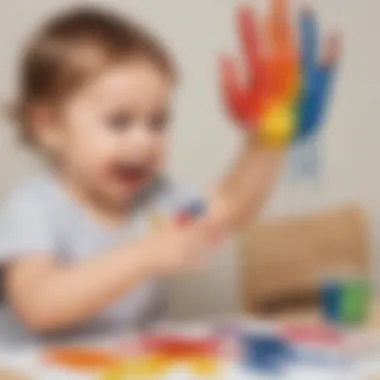
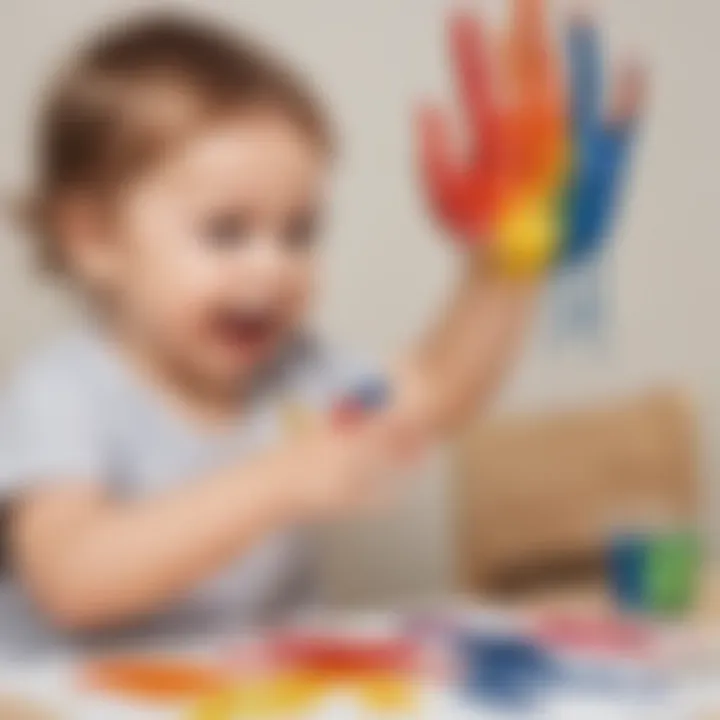
Language Development Exercises
Storytime Practices
Storytime practices are fundamental in stimulating vocabulary and listening ability. Reading puts images to words engaging children's minds at its early stage. The characteristic of storytime is shared reading, which brings together children and caregivers. Together they can explore different stories fosters bonding opportunity.
A unique aspect is its flexibility science; there’s no strict format for reading. Books can range from traditional to interactive formats. Some stories allow children role play or re-narrate that encourages speech. The downside is that not every child will naturally sit still. Choosing books that align with their interests increases engagement during storytime.
Sing-Along Activities
Sing-along activities aid in developing rhythms, language skills, and memorization. Singing familiar tunes adds excitement bringing about participation. This feature makes it beneficial as children delve into musical play while exploring language structure.
With varieties songs and themes., sing-alongs remain adaptable. That's unique for fostering speech skills in enjoyable ways. Covering many learning aspects all in one encompassing activity is an advantage. However, the requirement for repetition can sometimes make it feel dragging per child.
These educational activities support building foundational skills all necessary for children’s growth. Engaging them early with insightful implements champions lifelong learning ahead.
Physical Activities to Enhance Motor Skills
Physical activities are vital for two-year-olds as they help enhance motor skills while also making learning enjoyable. This developmental stage features fast physical growth and is characterized by the first stages of active play, which involves a mixture of gross and fine motor skills. Engaging in physical activities not only builds strength and coordination, but it supports social interaction and encourages a sense of achievement. Parents and educators must offer diverse opportunities for toddlers to explore their physical capabilities in both structured and unstructured settings.
Outdoor Games for Physical Development
Outdoor games serve as a significant component of physical activity for toddlers. They provide opportunities for kids to interact with their environment, engage in social play, and develop crucial motor skills. Here are two key outdoor games that improve physical development:
Ball Games
Ball games are exceptional in promoting gross motor skills in two-year-olds. These games, ranging from simple throws to interactive catching, help toddlers learn hand-eye coordination. A major key characteristic of ball games is their ability to captivate young children's attention, allowing them to remain engaged while also exercising. They can be easily modified to fit the space and skill level available.
Some unique features of ball games include:
- Variety: Different types—like soccer, basketball, or just rolling a ball back and forth—offer options.
- Simplicity: Basic rules invite toddlers to quickly jump in and understand.
The benefits include physical fitness and social skills. However, a potential drawback is the risk of frustration if a toddler struggles with coordination. Supervision and guidance can easily alleviate these moments of discomfort.
Obstacle Courses
Creating obstacle courses is another effective activity for enhancing motor skills in toddlers. These courses encourage children to run, jump, and climb, facets of physicality critical at this development stage. Kids experience problem-solving as they navigate various obstacles. The key characteristic of an obstacle course is its adaptability; it can be modified to fit different spaces or age levels.
Key elements that make obstacle courses enjoyable are:
- Creativity: Each setup can have unique challenges, like jumping over cushions or crawling under tables.
- Social Interaction: Children can work in pairs or small groups, promoting teamwork.
The main advantage of obstacle courses is their versatile nature. However, they require careful setup to ensure safety, especially if using larger equipment. Providing proper guidance encourages exploration while preventing unnecessary injuries.
Indoor Movement Activities
In addition to outdoor games, indoor movement activities offer ways for toddlers to expend energy and improve their motor skills. These activities often foster creativity and rhythm, making them enjoyable as well as beneficial. Two notable indoor movement fun activities are:
Simple Dance Routines
Incorporating dance boosts physical coordination through rhythm and expressive movement. Simple dance routines provide an accessible means of movement for toddlers. A key characteristic of such routines is their easy-to-follow nature. Even complex moves can be simplified for younger participants, keeping them engaged without overwhelming them.
Notable aspects include:
- Shared Enjoyment: Parents can join in, making it a fun bonding experience.
- Musicality: Exposure to music introduces kids to different rhythms and styles.
One possible disadvantage is the varying energy levels among children. Some may tire quickly, so keeping routines short can help maintain interest.
Movement Songs
Movement songs are another engaging way to promote physical activity while improving customs of song and dance. These songs often integrate actions that align with lyrics, encouraging kids to move along as they sing. A key feature of movement songs is their inherent joyfulness, which enhances the enjoyment of learning.
Benefits include:
- Physical Activity: Encourages moving different parts of the body through melodic instructions.
- Cognitive Skills: Helps toddlers link words to movements, improving language skills.
However, there can be a disparity in attention spans; some songs may resonate more than others. Choosing shorter, catchy tunes can ensure sustained enjoyment and participation.
Encouraging physical activities fosters essential motor skills and aids holistic development. Safety and supervision should always be a primary consideration.
Sensory Activities Encouraging Exploration
Sensory activities play a vital role in stimulating the senses of children, particularly those aged two. At this developmental stage, toddlers are naturally curious about their surroundings. Encouraging exploration through sensory play can significantly support their cognitive growth, fine motor skills, and social interactions. By engaging in such activities, children not only learn about their environment but also discover how to process sensory information.
Sensory activities can range from hands-on exploration to more defined tasks such as building and sorting. These types of activities aid in developing problem-solving skills while also fostering creativity. Parents and educators should consider incorporating various sensory experiences into children's playtime to enhance learning outcomes.
Sensory Bins: A Tactile Experience
Materials for Sensory Play
The selection of materials for sensory play is critical to its success. Common choices include dried rice, beans, sand, or water beads. These materials offer different textures that capture children's attention and invite interaction. Each element not only provides tactile stimulation but also encourages imaginative play.
One key characteristic of sensory materials is their versatility. For instance, dried pasta can be used in different ways: filling, sorting, or even building as children explore. The primary advantage of these materials is their accessibility; many options can be found at home or easily purchased without steep costs. However, parents must ensure that materials are suitable for toddlers to avoid potential choking hazards.
Theme Ideas for Bins
Theme ideas for sensory bins can vary greatly, each offering unique learning opportunities tailored to interests. From ocean themes that incorporate shells and water to farm-themed bins filled with animal figures, each bin can delve into different ecosystems or cultures. These themes make sensory play more engaging and relevant for the child’s growing curiosity.
Moreover, thematic bins are notable for their educational value. They allow for storytelling or lesson integration about the world around them. The diverse features enable findings such as animal sounds or characteristics when exploring “farm” or “ocean” bins.
However, parents should keep in mind that overly complex themes may overwhelm a toddler. It is essential to maintain simplicity, ensuring the activities remain focused and engaging for their developing minds.
Water Play and Experimentation
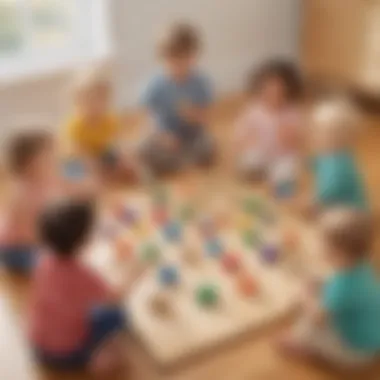
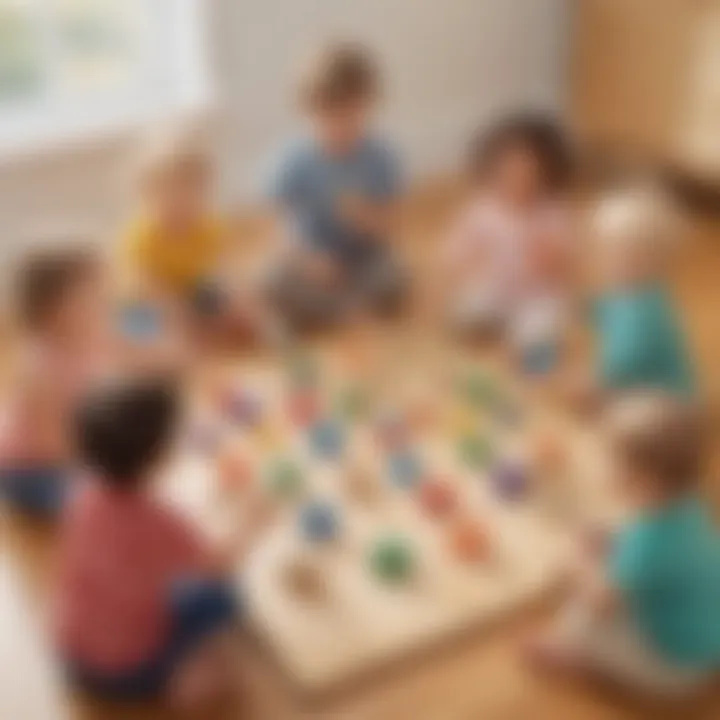
Benefits of Water Play
Water play is tremendously beneficial for children's exploration and learning. It provides opportunities for discovering concepts like floating or sinking, adding layers of scientific understanding to playtime. Engaging in this activity also enhances hand-eye coordination and fine motor skills when children use different tools such as cups, funnels, or sponges.
A critical advantage of water play is its inherent calming effect. Many children find playing with water soothing; this helps alleviate stress and encourages prolonged focus. Furthermore, exposure to water allows them to explore, teaching cause and effect, as they see what happens when objects enter or interact with it.
Simple Water Play Setup
Setting up simple water play can be exceptionally easy and inventive. Parents can easily transform bathtubs, sinks, or even dish tubs into water stations using everyday items at home. Tools like plastic cups, small containers, and bath toys can lead to fun experiments and discoveries.
The main feature that makes this setup appealing is the simplicity and accessibility. There are no elaborate preparations needed; so a spontaneity in play regularly happens. Ease of setup is especially appreciated by caregivers as it allows more time for active involvement rather than preparation.
Nevertheless, supervision is paramount. As water might pose a drowning risk, it is essential to remain an active presence during water play.
Incorporating sensory activities can build foundational skills for two-year-olds, enriching their exploration and learning experiences through play.
Routine Activities to Build Daily Skills
Routine activities for two-year-olds play a critical role in nurturing daily skills. These routines help toddlers develop independence, a sense of structure, and self-discipline. Providing consistent opportunities for toddlers to learn within their daily lives creates a supportive learning environment. As parents and educators incorporate these activities, they can enhance a child's growth in various aspects, particularly in personal care, communication, and cognitive development.
Incorporating Learning into Daily Routines
Integrating learning into daily routines is essential for developing useful skills. It takes simple, everyday moments and transforms them into chances for growth.
Mealtime Learning Tasks
Mealtime offers a key opportunity for engaging toddlers in learning. These tasks can include counting utensils or practicing vocabulary by naming foods. This aspect highlights how mealtime can be tailored to support active learning. Mealtime learning tasks are practical and provide special benefits, as they encompass nutritional knowledge and social skills.
Unique features include the ability to introduce new concepts like sharing, waiting, and even allowing all to express preferences. This hands-on approach not only keeps children engaged but enhances their understanding of numbers, colors, taste, and textures. However, focusing too much on structured learning during meals could lead to stress if the child feels pressured. Balancing education with natural interactions is key.
Self-Care Skills
Teaching self-care skills can offer lifelong benefits. These skills include practices such as washing hands, brushing teeth, and dressing. Highlighting personal responsibility at an early age helps develop independence. For toddlers, self-care moments are crucial in nurturing self-confidence.
Self-care activities can create a constructive framework that helps youath understand personal care routines. A unique aspect is the positive reinforcement children receive when they can complete tasks on their own. However, parents should be cautious of setting unrealistic expectations. Allowing for mistakes will foster growth without promoting frustration.
Structured Playtime Strategies
Incorporating structured playtime is also valuable because it allows toddlers to engage with set learning goals while still enjoying freedom of exploration.
Creating a Schedule
Creating a schedule brings a sense of order into a child's daily routine. Providing a framework can improve predictability, which supports their emotional and cognitive development. This approach at its core indicates that children thrive with consistency. By incorporating a schedule, you enhance their understanding of time management and prior expectations.
The unique feature of having a structured schedule is that it can include free play mixed with more directive activities. However, over-scheduling can lead to stress or create a sense that there is no room for spontaneous creativity.
Flexibility in Learning
Flexibility should be playing a significant role in any learning strategy. It encourages adaptive thinking and problem-solving behaviors, allowing toddlers to learn and thrive intuitively. Emphasizing adaptiveness can greatly enrich their learning experiences. A flexible approach balances structure with spontaneity by picnic opportunities for child-led play attempts.
This encourages a low-pressure environment where children feel comfortable experimenting, discovering limits, and trying new things. However, finding this balance often requires conscious attention to timing and instincts. Over-identifying flexibility can lead to chaotic situations, so moderation must be instructor’s focus to create optimal conditions for learning engagement.
Routine activities not only provide essential skills but shape children's understanding to handle daily tasks confidently.
When guided thoughtfully, these activities will foster foundational lessons that support social, emotional, and cognitive growth, allowing two-year-olds to embrace learning in all aspects of their daily lives.
Safety Considerations for Activities
Children of two years old are naturally curious and seek to explore their environment. As such, parents and educators must prioritize safety when engaging them in various activities. Ensuring a secure environment allows children to explore freely while minimizing risks.
Choosing Safe Materials
Selecting materials for activities is crucial. Parents and educators should aim for non-toxic items that are safe for toddlers. This means steering clear of small parts that could be choking hazards and materials that might cause allergic reactions.
When it comes to arts and crafts, using age-appropriate supplies is essential. Consider materials such as washable paints, large crayons, and sturdy paper. Avoid products with small pieces or sharp edges. This small step directly influences the child’s willingness to engage in creative activities, effectively setting the foundation for positive experiences.
Additionally, here are some key points to consider:
- Check labels for age recommendations.
- Educators should involve children in discussions about safety by explaining why certain materials are not suitable.
- Provide supervision when trying out new materials. Observe how children use them to ensure their safety.
Supervision Essentials
Active and vigilant supervision of toddlers during activities cannot be overemphasized. It is the responsibility of caregivers to remain present and engaged. This allows children to feel secure and ensures that risky behaviors are immediately addressed.
When supervising two-year-olds:
- Position yourself within eyesight to closely monitor the child’s actions.
- Anticipate potential hazards, such as slipping during play and choking on materials.
- Intervene quickly if the child engages with unsafe items or participates in dangerous play activities.
Encouraging safe exploration requires prepared supervision. If educators follow these practical guidelines, many dangerous situations can be prevented.
Remember, the aim is not to restrict exploration but to facilitate it safely. In nurturing curiosity with safety in mind, children can thrive in their learning environments.
Finale
In this article, we have explored various activities designed for two-year-olds. These activities encompass creative, educational, and physical dimensions which are vital for holistic development at this age.
It is clear that engaging toddlers in diverse forms of play promotes not just enjoyment, but also enhances their cognitive, motor, and social skills. As children play, they're not just engaging in fun; they're actively learning. Cognitive skills are built through puzzles and problem-solving games, while physical activity boosts motor skills and coordination.
Furthermore, social-emotional growth is significant at this age. Through group play, children learn to share, take turns, and express emotions. These interpersonal interactions shape their ability to connect with peers in later life.
"Play is the highest form of research." - Albert Einstein
This quote is particularly relevant when considering the context of early childhood. By facilitating playful learning, parents and educators can help foster resilience and adaptability in children.
In considering these engaging activities, some key elements are crucial for effective implementation:
- Safety: Always ensure that materials used are non-toxic and age-appropriate.
- Variety: Incorporate a mix of activities to sustain interest and cater to different learning styles.
- Routine: Consistent engagement through play helps build expectations and enriches learning.
The benefits are profound. Children develop essential life skills while experiencing joy and wonder. For parents and educators, understanding these dynamics is vital for enhancing children's formative years. As we conclude, it's important to reflect on the critical role that positive, structured, and thoughtful play has on nurturing the minds of young children. With each facilitated activity, we help lay a robust foundation for their future learning and growth.







